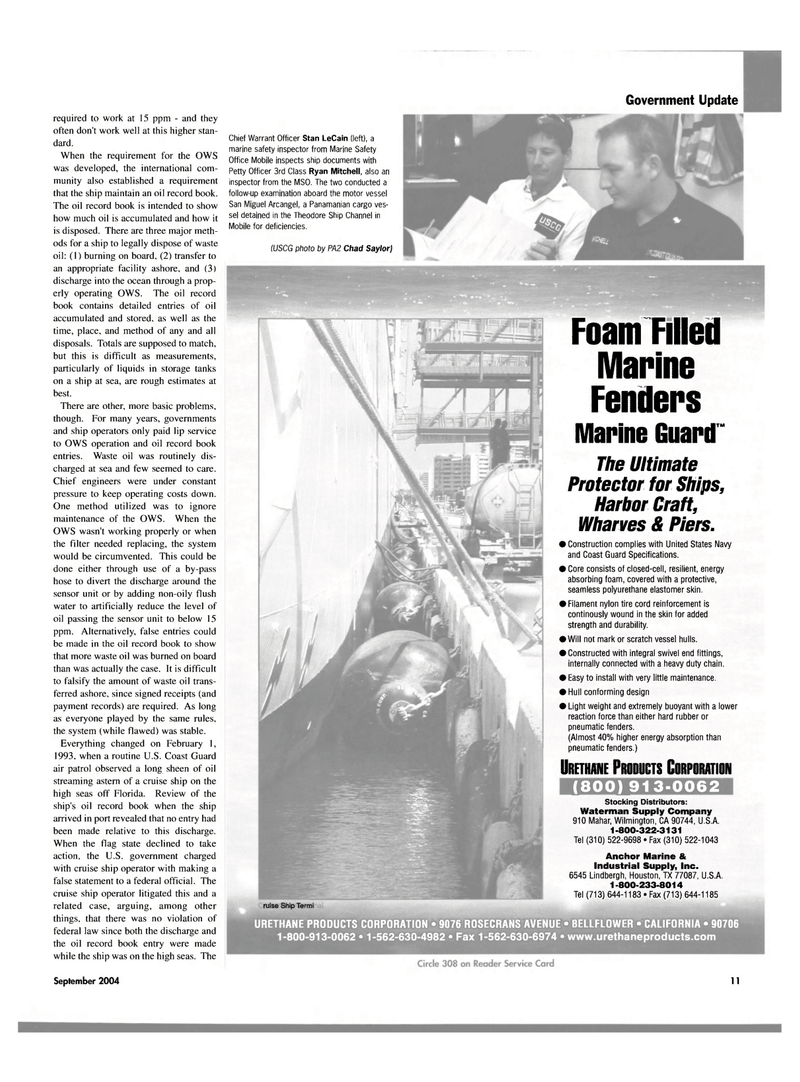
Page 11: of Maritime Reporter Magazine (September 2004)
Marine Propulsion Annual
Read this page in Pdf, Flash or Html5 edition of September 2004 Maritime Reporter Magazine
required to work at 15 ppm - and they often don't work well at this higher stan- dard.
When the requirement for the OWS was developed, the international com- munity also established a requirement that the ship maintain an oil record book.
The oil record book is intended to show how much oil is accumulated and how it is disposed. There are three major meth- ods for a ship to legally dispose of waste oil: (1) burning on board. (2) transfer to an appropriate facility ashore, and (3) discharge into the ocean through a prop- erly operating OWS. The oil record book contains detailed entries of oil accumulated and stored, as well as the time, place, and method of any and all disposals. Totals are supposed to match, but this is difficult as measurements, particularly of liquids in storage tanks on a ship at sea, are rough estimates at best.
There are other, more basic problems, though. For many years, governments and ship operators only paid lip service to OWS operation and oil record book entries. Waste oil was routinely dis- charged at sea and few seemed to care.
Chief engineers were under constant pressure to keep operating costs down.
One method utilized was to ignore maintenance of the OWS. When the
OWS wasn't working properly or when the filter needed replacing, the system would be circumvented. This could be done either through use of a by-pass hose to divert the discharge around the sensor unit or by adding non-oily flush water to artificially reduce the level of oil passing the sensor unit to below 15 ppm. Alternatively, false entries could be made in the oil record book to show that more waste oil was burned on board than was actually the case. It is difficult to falsify the amount of waste oil trans- ferred ashore, since signed receipts (and payment records) are required. As long as everyone played by the same rules, the system (while flawed) was stable.
Everything changed on February 1, 1993, when a routine U.S. Coast Guard air patrol observed a long sheen of oil streaming astern of a cruise ship on the high seas off Florida. Review of the ship's oil record book when the ship arrived in port revealed that no entry had been made relative to this discharge.
When the flag state declined to take action, the U.S. government charged with cruise ship operator with making a false statement to a federal official. The cruise ship operator litigated this and a related case, arguing, among other things, that there was no violation of federal law since both the discharge and the oil record book entry were made while the ship was on the high seas. The
Chief Warrant Officer Stan LeCain (left), a marine safety inspector from Marine Safety
Office Mobile inspects ship documents with
Petty Officer 3rd Class Ryan Mitchell, also an inspector from the MSO. The two conducted a follow-up examination aboard the motor vessel
San Miguel Arcangel, a Panamanian cargo ves- sel detained in the Theodore Ship Channel in
Mobile for deficiencies. (USCG photo by PA2 Chad Saylor)
Government Update (800) 913-0062 ruise Ship Termi
Anchor Marine &
Industrial Supply, Inc. 6545 Lindbergh, Houston, TX 77087, U.S.A. 1-800-233-8014
Tel (713) 644-1183 • Fax (713) 644-1185
URETHANE PRODUCTS CORPORATION • 9076 ROSECRANS AVENUE • BELLFLOWER • CALIFORNIA • 90706 1-800-913-0062 • 1-562-630-4982 • Fax 1-562-630-6974 • www.urethaneproducts.com mm Foam Filled
Marine Fenders
Marine Guard "
The Ultimate
Protector for Ships,
Harbor Craft,
Wharves & Piers. • Construction complies with United States Navy and Coast Guard Specifications. • Core consists of closed-cell, resilient, energy absorbing foam, covered with a protective, seamless polyurethane elastomer skin. • Filament nylon tire cord reinforcement is continously wound in the skin for added strength and durability. • Will not mark or scratch vessel hulls. • Constructed with integral swivel end fittings, internally connected with a heavy duty chain. • Easy to install with very little maintenance. • Hull conforming design • Light weight and extremely buoyant with a lower reaction force than either hard rubber or pneumatic fenders. (Almost 40% higher energy absorption than pneumatic fenders.)
URETHANE PRODUCTS CORPORATION
Stocking Distributors:
Waterman Supply Company 910 Mahar, Wilmington, CA 90744, U.S.A. 1-800-322-3131
Tel (310) 522-9698 • Fax (310) 522-1043
September 2004 11

 10
10

 12
12
